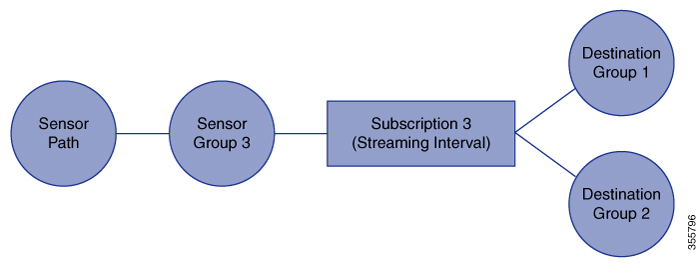This example displays how to create a subscription that streams interface statistic data from Fibre Channel interface 3/1
and 4/1 every 30 seconds to IP 1.2.3.4 port 50003 and IP 1:1::1:1 port 50009, and encrypts the stream using GPB encoding that
is verified using test.pem:
switch# configure terminal
switch(config)# telemetry
switch(config-telemetry)# certificate /bootflash/test.pem foo.test.google.fr
switch(conf-tm-telemetry)# destination-group 100
switch(conf-tm-dest)# ip address 1.2.3.4 port 50003 protocol gRPC encoding GPB
switch(conf-tm-dest)# destination-group 1
switch(conf-tm-dest)# ipv6 address 1:1::1:1 port 50009 protocol gRPC encoding GPB-compact
switch(config-dest)# sensor-group 100
switch(conf-tm-sensor)# path show_stats_fc3/1
switch(conf-tm-sensor)# subscription 100
switch(conf-tm-sub)# snsr-grp 100 sample-interval 30000
switch(conf-tm-sub)# dst-grp 100
switch(config-dest)# sensor-group 1
switch(conf-tm-sensor)# path show_stats_fc4/1
switch(conf-tm-sensor)# subscription 1
switch(conf-tm-sub)# snsr-grp 1 sample-interval 30000
switch(conf-tm-sub)# dst-grp 1
This example displays how to create a periodic collection of show command data every 30 seconds and sends it to receivers 1.2.3.4 and 1.1::1.1:
switch# configure terminal
switch(config)# telemetry
switch(config-telemetry)# destination-group 100
switch(conf-tm-dest)# ip address 1.2.3.4 port 60001 protocol gRPC encoding GPB
switch(conf-tm-sensor)# destination-group 1
switch(conf-tm-dest)# ipv6 address 1:1::1:1 port 60009 protocol gRPC encoding GPB-compact
switch(config-dest)# sensor-group 100
switch(conf-tm-sensor)# subscription 100
switch(conf-tm-sub)# snsr-grp 100 sample-interval 30000
switch(conf-tm-sub)# dst-grp 100
switch(conf-tm-dest)# sensor-group 1
switch(conf-tm-sensor)# subscription 1
switch(conf-tm-dest)# snsr-grp 1 sample-interval 30000
switch(conf-tm-sub)# dst-grp 1
This example displays that a sensor group can contain multiple paths, a destination group can contain multiple destination
profiles, and a subscription can be linked to multiple sensor groups and destination groups:
switch# configure terminal
switch(config)# telemetry
switch(config-telemetry)# sensor-group 100
switch(conf-tm-sensor)# path analytics:init
switch(conf-tm-sensor)# path analytics:initit
switch(config-telemetry)# sensor-group 200
switch(conf-tm-sensor)# path analytics:inititl
switch(conf-tm-sensor)# destination-group 100
switch(conf-tm-dest)# ip address 1.2.3.4 port 50004
switch(conf-tm-dest)# ipv6 address 5:6::7:8 port 50005
switch(conf-tm-dest)# destination-group 200
switch(conf-tm-dest)# ip address 5.6.7.8 port 50001
switch(conf-tm-dest)# subscription 600
switch(conf-tm-sub)# snsr-grp 100 sample-interval 30000
switch(conf-tm-sub)# snsr-grp 200 sample-interval 30000
switch(conf-tm-sub)# dst-grp 100
switch(conf-tm-sub)# dst-grp 200
switch(conf-tm-dest)# subscription 900
switch(conf-tm-sub)# snsr-grp 200 sample-interval 30000
switch(conf-tm-sub)# dst-grp 100

Note
|
The sensor_path is the location where the specific interface statistics and the push queries that are streamed are specified. Multiple sensor
paths can be configured in a sensor group. The sensor path for analytics streaming is path analytics:query_name , for interface statistics streaming it is path
show_stats_fc slot/port and for transceiver parameters it is path transceiver interface-range. The query names init, initit, and inititl that are specified in the sensor paths are configured in the SAN Analytics feature. For more information, see Configuring a Push Query.
|
This example shows a sample configuration of transceiver streaming.
switch# configure terminal
switch(config)# telemetry
switch(config-telemetry)# sensor-group 200
switch(conf-tm-sensor)# path transceiver:fc1/1
switch(conf-tm-sensor)# path transceiver:fc13/1-48
switch(conf-tm-sensor)# show telemetry data collector details
--------------------------------------------------------------------------------
Row ID Successful Failed Skipped Sensor Path(GroupId)
--------------------------------------------------------------------------------
1 398 14 0 show_stats_fc3/1-48(100)
2 30488 0 1 analytics:dcnmtgtITL(2)
3 395 0 0 show_stats_fc5/1-48(100)
4 0 0 0 transceiver:fc1/1(200)
5 0 0 0 transceiver:fc13/1-48(200)
6 0 0 0 analytics:dcnmtgtITN(1)
This example shows a sample configuration and how to verify an SAN Telemetry Streaming configuration. You can also check the
show telemetry data collector details and show telemetry transport
session_id
stats command outputs for verifying the SAN Telemetry Streaming configuration. For more information, see Displaying SAN Telemetry Streaming Configuration and Statistics.
switch# configure terminal
switch(config)# telemetry
switch(config-telemetry)# destination-group 100
switch(conf-tm-dest)# ip address 1.2.3.4 port 50003 protocol gRPC encoding GPB
switch(conf-tm-dest)# ip address 1.2.3.4 port 50004 protocol gRPC encoding GPB
switch(config-telemetry)# destination-group 1
switch(conf-tm-dest)# ipv6 address 1:1::1:1 port 50008 protocol gRPC encoding GPB-compact
switch(conf-tm-dest)# ipv6 address 1:2::3:4 port 50009 protocol gRPC encoding GPB-compact
switch(conf-tm-dest)# end
switch# show running-config telemetry
!Command: show running-config telemetry
!Running configuration last done at: Thu Jun 14 08:14:24 2018
!Time: Thu Jun 14 08:14:40 2018
version 8.3(1)
feature telemetry
telemetry
destination-group 1
ipv6 address 1:2::3:4 port 50008 protocol gRPC encoding GPB-compact
ipv6 address 1:1::1:1 port 50009 protocol gRPC encoding GPB-compact
destination-group 100
ip address 1.2.3.4 port 50003 protocol gRPC encoding GPB
ip address 1.2.3.4 port 50004 protocol gRPC encoding GPB

Note
|
NPU load is based on all ITLs, including the count of active and inactive ITLs. Hence, we recommend that you clear or purge
queries before checking the NPU load.
|





 Feedback
Feedback